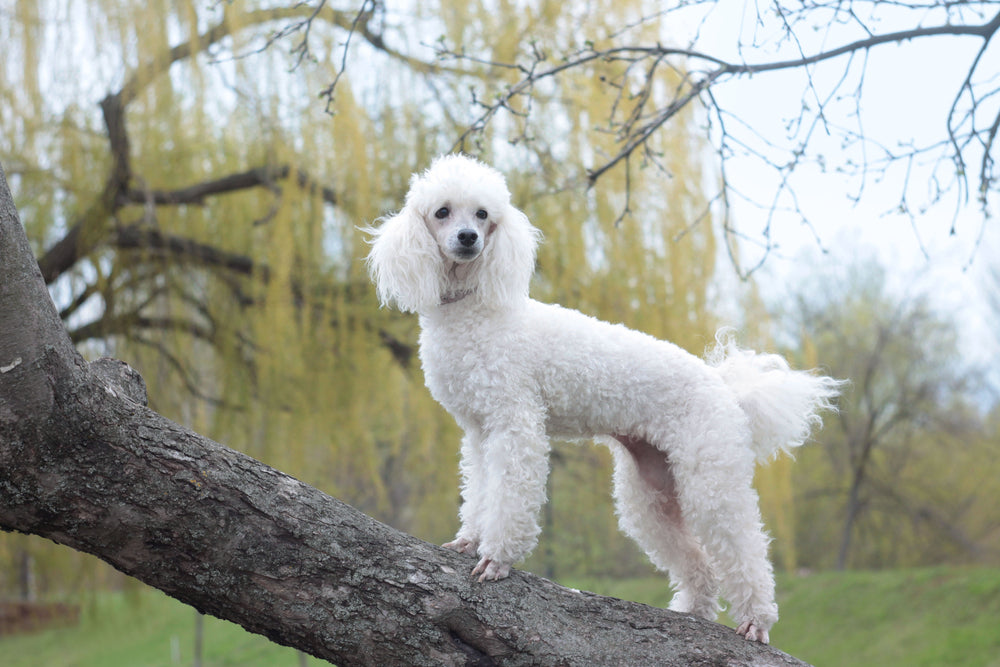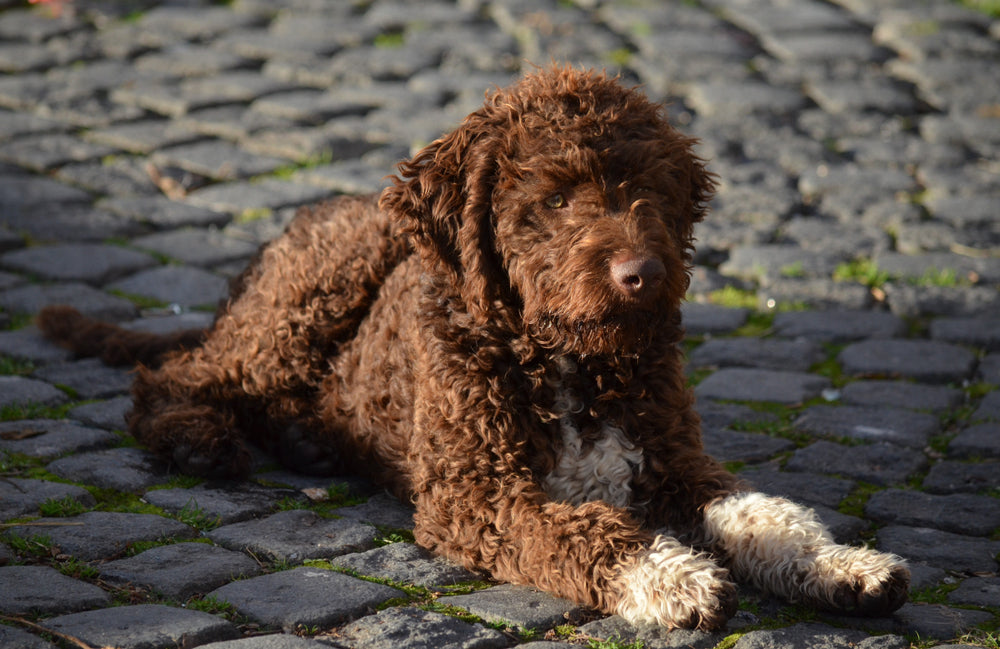It can be frustrating when allergies prevent you or your loved ones from adopting a furry companion. Traditionally, people with pet allergies have had two choices—choose a cold-blooded pet (or no pet at all) or try to cope with the allergic reactions caused by living with a dog. Could there be a third option?
When the former president adopted Bo, the “hypoallergenic” dog, potential pet owners across the country started to get their hopes up. Was it really possible for people with pet allergies to become dog owners? Below, learn about top hypoallergenic dog breeds and whether they could be the answer for people with pet allergies.
What does “hypoallergenic” mean and is it real?
Dogs are the most popular house pet in the country, according to the American Pet Products Association’s 2017-2018 National Pet Owners Survey. In fact, canines are a part of 48% of households in the United States. The idea of a “hypoallergenic” dog could mean that allergies do not have to stand in the way of experiencing the joys of adopting a furry friend.
When people talk about “hypoallergenic” dogs, they are referring to dogs that may not cause allergic responses in people that are sensitive to pet dander. Before breaking down the science behind hypoallergenic dogs, let us first discuss what it means to have a pet allergy.
What is a pet allergy?
When you are allergic to furry pets such as cats and dogs, it means that your immune system reacts to certain properties in their dander (dead skin cells), saliva or urine. Contact with these allergens may cause your eyes to itch or your nose to run. In people with more severe pet allergies, exposure to pet dander can cause rashes and breathing difficulties.
Hypoallergenic dogs are said to release less pet dander into the air, providing a way for people with pet allergies to enjoy the company of these faithful companions (Nicholas, et. al, 2011). For people with pet allergies, not having a dog is often the most recommended option. However, many people refuse to give up on finding a way to welcome a dog into their home.
Can hypoallergenic dogs still produce allergens?
There are a few different allergens found in dogs, most of which can be found in pet dander and saliva. Since all dogs have skin and produce saliva, it is not possible for a dog to be completely hypoallergenic.
Homes with hypoallergenic dog breeds have been found to have similar concentrations of household pet dander as homes with non-hypoallergenic dog breeds. The results were significant enough for the study authors to warn clinicians against recommending hypoallergenic dogs to patients with pet allergies (Nicholas, et. al, 2011).
According to Dr. Robert Wood, an allergist at the Johns Hopkins Children’s Center, the likelihood of a dog being hypoallergenic is rare and depends on the individual dog. Dogs of the same breed can have different skin types and produce different proteins. Therefore, individual dogs can have different effects on people with pet dander allergies.
Why are dogs thought to be “hypoallergenic?”
In addition, many dog breeds are thought to be hypoallergenic because they have little hair or because they do not shed. This may not necessarily be true, because humans aren’t allergic to dog hair, they’re allergic to pet dander. However, areas of your home that accumulate dog hair may also be more likely to accumulate allergens such as pet dander and saliva.
In short, there is no fail-safe hypoallergenic dog. Fortunately, this does not necessarily mean that you have to give up your dreams of becoming a dog owner. According to the Asthma and Allergy Foundation of America, some people may be more sensitive to certain breeds of dogs. For those people, adopting a dog that does not cause an allergic reaction may just be a matter of finding the right breed.
What are the top 10 “hypoallergenic” dog breeds?
While there is no dog breed that is guaranteed to not cause allergic responses in people that are sensitive to pet dander, there are dogs that have shown to be better suited for people with pet allergies.
According to the American Kennel Club, dogs that have a non-shedding coat may produce less dander and, therefore, may be more suitable for aspiring dog owners with pet allergies.
Here’s a list of the top hypoallergenic dog breeds recommended for people with pet allergies:
-
Bichon Frise—These friendly dogs are gentle and playful. They are known for being good with children. This breed’s curly white fur grows continuously. This means that they do not shed, but do require regular grooming.

- American hairless terrier—As you might have guessed, this breed of dog has no fur at all. Because they have no fur, American hairless terriers need a little extra care to keep their skin healthy. This may be worth it for their lowered potential to induce allergic reactions in people allergic to pet dander.
- Schnauzer—These dogs may have a lot of fur, but they actually shed very little. When brushed regularly, they may release less pet dander in your home.
- Maltese—This is another breed of dog that has plenty of fur, but rarely sheds. It is best to brush your Maltese daily. These dogs are known to be both extremely playful and unfailingly loyal.
-
Poodle—Poodles are often touted as one of the most popular hypoallergenic dog breeds. Dogs of this breed are available in a wide range of sizes and are very active and intelligent. Poodles require regular grooming and shaving.

-
Spanish water dog—Similar in appearance to poodles, the Spanish water dog is a high-energy breed best for families with active lifestyles. Unlike other top hypoallergenic breeds, this dog does not need regular grooming. It is best to shave your Spanish water dog once a year.

- Bedlington terrier—This breed is known for being extremely affectionate and smart. Their thick, curly fur is not prone to shedding and they require little exercise other than normal daily playtime and walks.
- Soft coated wheaten terrier—These terriers are high-energy and extremely playful. They have a soft fur coat and rarely shed, as long as they are brushed at least once a week.
- Portuguese water dog—The Portuguese water dog is another example of a top hypoallergenic dog breed that has an abundance of fur, but rarely sheds. These dogs are very athletic and loyal. Their fur is water-resistant and requires regular grooming. Similarly, the Irish water spaniel is also thought to be a good choice for people with pet allergies.
-
Kerry blue terrier—Known for their friendliness and intelligence, Kerry blue terriers enjoy being a part of an active household. They shed very little, but their coats require regular brushing and grooming.

Helpful tips for pet lovers with allergies
While the best recommendation for people with pet allergies is to not have a dog, there are actions that you can take to lessen your chances of adverse allergic reactions. If you are thinking of adopting a dog, it is a good idea to find an animal shelter or foster home that will allow you to adopt on a trial basis. Just because a dog is thought to be hypoallergenic does not necessarily mean that their dander will not cause an allergic reaction.
It’s not impossible for people with pet allergies to live in harmony with a furry companion, it just may take a little bit of extra work. If you already have a dog, there are steps that you can take to minimize the amount of pet dander that you encounter each day:
- Clean or eliminate allergen reservoirs—Carpets, upholstered furniture and bedding accumulate pet dander over time and can contribute to allergic reactions. If possible, replace carpets with tile or wood floors. Pet owners with carpeting should vacuum frequently, preferably with a high-efficiency vacuum. Bedding and furniture should be washed regularly.
- Wash your dog regularly—Studies have shown that washing your dog can greatly reduce airborne pet allergens. Washing your dog regularly allows you to remove pet dander from the dog’s fur before it has the chance to be released into the environment. Try to wash the dog at least twice a week to reduce airborne pet allergens.
- Keep the dog out of your bedroom—Excluding the dog from certain rooms in your home could cause those rooms to have a lower concentration of airborne allergens. For example, keeping the dog out of your child’s bedroom means that your child may be less exposed to pet dander when they are in that room.
- Let your dog outside—The more time that your dog spends outside, the less pet dander that could have the chance to accumulate in your home. If your dog cannot be outdoors for most of the day, you should at least make sure to brush them outside. If you have pet allergies, you can wear a dust mask while brushing your dog or ask someone without allergies to brush them.
- Use an air filter—As you will see in the next section, airborne pet allergens are common in homes with furry pets. Breathing in these allergens can cause adverse reactions in people with pet allergies. Using an air filter can help improve your indoor air quality and reduce the amount of pet dander in the air.
How does pet dander affect indoor air quality?
Though pet dander will eventually settle and become a part of the dust that you find around your home, it spends far more time in the air than you may think. Airborne pet dander particles come in different sizes. Smaller allergen particles tend to stay airborne for long periods of time, according to the American Academy of Allergy, Asthma & Immunology (AAAAI).
When you inhale these particles, they have the ability to reach all the way to your lower airways. In people with pet allergies, inhaling these particles can cause allergic reactions or trigger asthma symptoms.
The number of dogs that you have does not actually affect the levels of pet dander found in the air inside your home. Even homes without pets have been found to contain low levels of pet dander in the air, though not as much as homes with dogs. Likewise, rooms from which the dog is excluded may have lower levels of airborne pet allergens than rooms in which the dog is allowed. Fortunately, there are many ways for you to decrease the amount of airborne pet allergens and improve the indoor air quality of your home.
Are air purifiers effective against pet dander?
Whether you adopt a “hypoallergenic” dog or opt for a regular breed, your new pet can have an impact on the indoor air quality of your home. People with pet allergies are especially susceptible to the increased amounts of airborne pet dander.
Most pet dander particles are big enough to be picked up by HEPA air filters. However, without additional purification technology there is a chance that smaller particles may pass through the HEPA filter and be circulated back into the air. Learn more about the different types of air filters and how they can decrease airborne pet dander in your home.
Our solution
The Molekule air purifier can destroy pet dander allergens from the air. The Molekule technology can also remove mold and pollen, allergens that may be carried on the backs of your furry friends.
The quest to find the top “hypoallergenic” dog is well-intended and caused quite a stir, especially with Bo, the First Dog of the Obama administration. Though there is no dog or furry creature that is truly allergen-free, pet lovers with allergies can find the right solutions for them to live alongside their four-legged pals.
Headline Image: Courtesy Barack Obama Presidential Library. “Bo, left, and Sunny, the Obama family dogs, on the South Lawn of the White House, August 19, 2013.”












